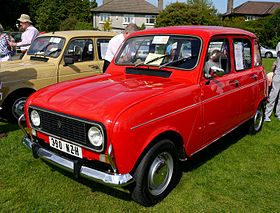Renault 4L
| Renault 4 | |
|---|---|
 |
|
| Overview | |
| Manufacturer | Renault |
| Also called | Renault R3 Renault R4 |
| Production | 1961–1992 (until 1994 in Slovenia) |
| Assembly |
|
| Body and chassis | |
| Class | Economy car, Supermini, Subcompact |
| Body style | 2-door pickup truck 2-door van 5-door hatchback |
| Layout | MF layout |
| Related |
Renault 5 Renault 6 Renault 7 Renault Rodeo |
| Powertrain | |
| Engine | 45.6 cu in (0.7 L) I4 51.5 cu in (0.8 L) I4 58.3 cu in (1.0 L) I4 67.6 cu in (1.1 L) I4 |
| Transmission | 3-speed manual 4-speed manual |
| Dimensions | |
| Wheelbase | 2,440 mm (96.1 in) (right) 2,395 mm (94.3 in) (left) |
| Length | 3,663 mm (144.2 in) |
| Width | 1,485 mm (58.5 in) |
| Height | 1,470 mm (57.9 in) |
| Curb weight | 600–750 kg (1,323–1,653 lb) |
| Chronology | |
| Predecessor | Renault 4CV |
| Successor | Renault Twingo |
The Renault 4, also known as the 4L (pronounced "Quatrelle"), is a hatchback economy car produced by the French automaker Renault between 1961 and 1994. It was the first front-wheel drive family car produced by Renault.
The car was launched at a time when several decades of economic stagnation were giving way to growing prosperity and surging car ownership in France. The first million cars were produced by 1 February 1966, less than four and a half years after launch; eventually over eight million were built, making the Renault 4 a commercial success because of the timing of its introduction and the merits of its design. Although originally marketed as a small estate car, it is now regarded as the first mass production hatchback car.
The Renault 4 was Renault's response to the 1948 Citroën 2CV. Renault was able to review the advantages and disadvantages of the 2CV design and come up with a larger, more urban vehicle. In early 1956, Renault Chairman Pierre Dreyfus launched this new project: designing a new model to replace the rear engined 4CV that would become an everyman's car, capable of satisfying the needs of most consumers. It would be a family car, a woman's car, a farmer's car, or a city car.
Renault launched the Renault 3 and the Renault 4 simultaneously in July 1961. The cars shared the same body and most mechanical components, but the R3 was powered by a 603 cc version of the engine while the R4 featured a 747 cc engine. This placed the R3 in the 3CV taxation class while the R4 was in the 4CV class. Actual maximum power output was claimed by Renault as 22.5 hp for the R3, and 26.5 or 32 hp for the R4, depending on price level and the type of carburettor fitted. Initially the base versions of the R3 and R4 came with a thick C-pillar behind each of the rear doors. Quarter glass was a 400 francs option for the basic R4. The extra visibility increased the weight of the vehicle, but these windows soon became standard for all R4s.
...
Wikipedia
